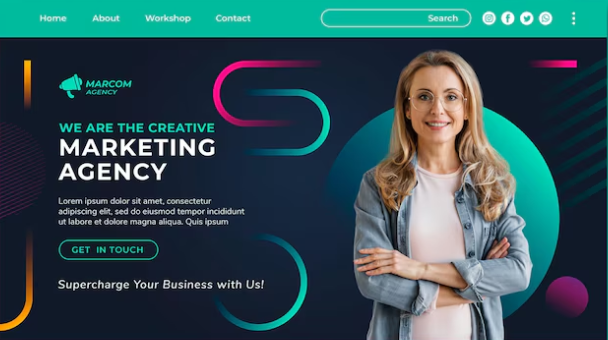A landing page is a standalone web page designed for marketing or advertising purposes. Its main goal is to convert visitors into leads or customers by focusing on a single objective. Unlike a homepage, which serves as a gateway to various sections of a website, a landing page targets a specific campaign, product, or service. This focused design makes landing pages a crucial component of digital marketing strategies.

Table of Contents
Purpose of a Landing Page
The primary purpose of a landing page is to drive a specific action from visitors. This can range from signing up for a newsletter to making a purchase. By narrowing the focus, landing pages eliminate distractions and increase the likelihood of conversion. Here are some common purposes:
Lead Generation: Many businesses use landing pages to collect leads by offering valuable content, such as eBooks or free trials, in exchange for contact information.
Sales: E-commerce sites often create landing pages for specific products or promotions to boost sales and direct traffic to a product.
Event Registration: Organizations promote events through dedicated landing pages, encouraging visitors to register or buy tickets.
Product Launches: When introducing a new product, a landing page provides detailed information, highlights features, and generates interest.
Promotional Campaigns: Businesses create landing pages to support specific marketing campaigns, showcasing limited-time offers or discounts.
Key Elements of a Landing Page
An effective landing page includes several key elements designed to maximize conversion rates:
1. Compelling Headline
The headline captures visitors’ attention immediately. A strong headline is clear, concise, and communicates the value of what you’re offering.
2. Subheadline
A subheadline supports the main headline and provides additional information about the offer. It encourages visitors to engage with the content.
3. Engaging Visuals
Images or videos illustrating the product or service enhance the landing page’s appeal. High-quality visuals help convey the message more effectively.
4. Clear Call to Action (CTA)
A CTA is a button or link that prompts users to take the desired action, such as “Sign Up Now” or “Get Started.” The CTA should be prominent and easy to find.
5. Concise Copy
The body copy should be clear and focused, explaining the benefits of the offer and encouraging action. Keeping the text concise helps avoid overwhelming the reader.
6. Social Proof
Incorporating testimonials, reviews, or case studies builds trust and credibility. Social proof shows that others have benefited from the product or service, encouraging new visitors to convert.
7. Lead Capture Form
For lead generation landing pages, a form is crucial for collecting visitor information. The form should be simple, asking only for essential details to increase submissions.
8. Minimal Distractions
To maximize conversions, landing pages should limit distractions. This means reducing navigation options and unnecessary information that could divert visitors from the primary goal.
9. Responsive Design
With the growing use of mobile devices, landing pages must adapt to various screen sizes, ensuring they look great and function well on all devices.
10. Thank You Page
After conversion, directing users to a thank you page reinforces the action taken. This page can offer additional information or encourage social sharing.
Types of Landing Pages
Landing pages can be categorized based on their objectives:
1. Lead Generation Landing Pages
These pages collect user information in exchange for valuable content or offers. They typically include a lead capture form prominently displayed alongside compelling offers.
2. Click-Through Landing Pages
Click-through landing pages act as intermediaries that lead visitors to a final conversion point. They provide brief information about a product or service and encourage users to click through to another page.
3. Sales Landing Pages
Focused on selling a specific product or service, these pages provide detailed information about features, benefits, and pricing, often including persuasive elements like testimonials.
4. Event Landing Pages
Designed for promoting specific events, these pages include details about the event, such as date, location, agenda, and registration options.
5. Product Launch Landing Pages
These pages introduce new products, showcasing features, benefits, and offering pre-order or early-bird incentives.
Best Practices for Creating Landing Pages
To maximize the effectiveness of landing pages, consider implementing these best practices:
1. A/B Testing
Test different elements of your landing page, such as headlines, images, CTAs, and layouts, to determine which versions perform better. A/B testing can improve conversion rates over time.
2. Optimize for SEO
While landing pages often support targeted campaigns, optimizing them for search engines can increase organic traffic. Incorporate relevant keywords, meta tags, and descriptions to enhance visibility.
3. Utilize Analytics
Monitor the performance of your landing pages using analytics tools. Track metrics such as conversion rates, bounce rates, and user behavior to gain insights and make informed adjustments.
4. Fast Loading Speeds
A slow-loading landing page can deter potential customers. Optimize images and use reliable hosting services to promote quick loading times.
5. Create Urgency
Incorporate elements of urgency, such as limited-time offers or countdown timers, to encourage visitors to act quickly and reduce procrastination.
Conclusion
In the landscape of digital marketing, landing pages play a crucial role in converting visitors into leads and customers. By focusing on a single objective and employing best practices, businesses can create effective landing pages that drive results. Whether for lead generation, product sales, or event promotion, a well-designed landing page can significantly enhance marketing efforts and improve overall conversion rates. Understanding the key elements, types, and best practices helps marketers leverage landing pages to achieve business goals efficiently.